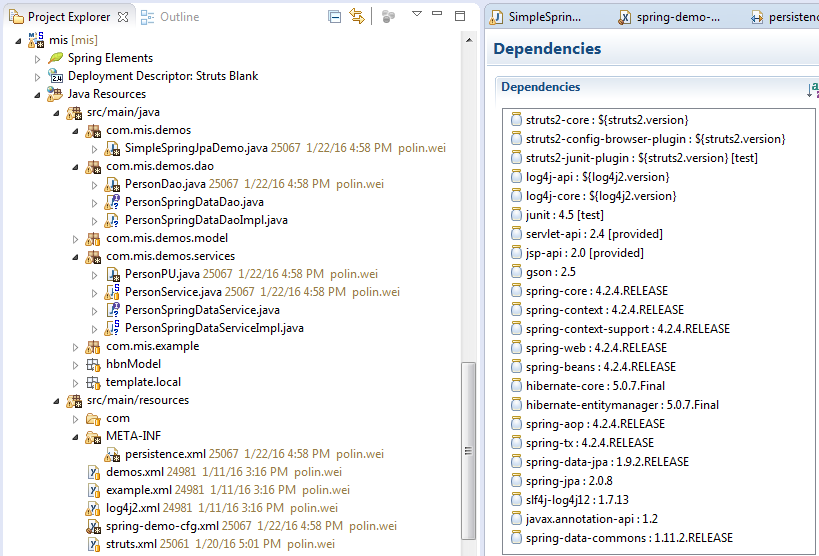配置:
Maven: pom.xml
<dependency>
<groupId>org.quartz-scheduler</groupId>
<artifactId>quartz</artifactId>
<version>2.2.2</version>
</dependency>
<dependency>
<groupId>org.quartz-scheduler</groupId>
<artifactId>quartz-jobs</artifactId>
<version>2.2.2</version>
</dependency> |
Quartz是一個任務進度管理器,以下做簡單的配置
Step 1. 编寫工作(Job class):SpringQuartzJobDemo.java ,需要繼承 spring 中的 QuartzJobBean,因為 QuartzJobBean 類實現了 Job 接口
package com.mis.demo;
import org.quartz.JobExecutionContext;
import org.quartz.JobExecutionException;
import org.springframework.scheduling.quartz.QuartzJobBean;
public class SpringQuartzJobDemo extends QuartzJobBean {
@Override
protected void executeInternal(JobExecutionContext context) throws JobExecutionException {
System.out.println("Business code ..");
}
}
|
Step 2. Quartz 定時任務,由 Spring 依賴注入配置方法
<?xml version="1.0" encoding="UTF-8"?>
<beans xmlns="http://www.springframework.org/schema/beans"
xmlns:xsi="http://www.w3.org/2001/XMLSchema-instance"
xmlns:jpa="http://www.springframework.org/schema/data/jpa"
xmlns:tx="http://www.springframework.org/schema/tx"
xmlns:context="http://www.springframework.org/schema/context"
xsi:schemaLocation="http://www.springframework.org/schema/beans http://www.springframework.org/schema/beans/spring-beans.xsd
http://www.springframework.org/schema/context http://www.springframework.org/schema/context/spring-context-4.2.xsd
http://www.springframework.org/schema/data/jpa http://www.springframework.org/schema/data/jpa/spring-jpa.xsd
http://www.springframework.org/schema/tx http://www.springframework.org/schema/tx/spring-tx.xsd">
<!-- Spring Quartz -->
<!--集成方式:MethodInvokingJobDetailFactoryBean,並且任務類別,是需要繼承QuartzJobBean-->
<!--定義jobDetail-->
<bean name="schedulingJob" class="org.springframework.scheduling.quartz.JobDetailFactoryBean">
<property name="jobClass" value="com.mis.demo.SpringQuartzJobDemo"/>
<property name="durability" value="true" />
</bean>
<!--定義Trigger觸發器: cronExpression 表達式的格式:秒 分 時 日 月 周 年(可選)-->
<bean id="triggerJob" class="org.springframework.scheduling.quartz.CronTriggerFactoryBean">
<property name="jobDetail" ref="schedulingJob"/>
<property name="cronExpression" value="*/5 * * * * ?" />
</bean>
<!--定義核心調度器-->
<bean id="scheduleController" class="org.springframework.scheduling.quartz.SchedulerFactoryBean" lazy-init="true">
<property name="schedulerName" value="monitorScheduler"/>
<property name="triggers">
<list>
<ref bean="triggerJob"/>
</list>
</property>
</bean>
</beans>
|
Step 3. 完成設定之後,只要啟動Spring並讀取定義檔完成後,排程任務就會進行,
撰寫一個簡單的任務啟動類別:SpringQuartzJobExcute.java
package com.mis.demo;
import org.quartz.SchedulerException;
import org.quartz.impl.StdScheduler;
import org.springframework.context.ApplicationContext;
import org.springframework.context.support.FileSystemXmlApplicationContext;
public class SpringQuartzJobExcute {
private static ApplicationContext APP_CONTEXT;
public static void main(String[] args) throws SchedulerException {
APP_CONTEXT = new FileSystemXmlApplicationContext("/src/main/resources/spring-demo-cfg.xml");
System.out.println("Start - ScheduleController");
getScheduleController().start();
}
/**
* get StdScheduler
*
* @return StdScheduler
*/
public static StdScheduler getScheduleController() {
StdScheduler bean = null;
bean = (StdScheduler) APP_CONTEXT.getBean("scheduleController", StdScheduler.class);
return bean;
}
}
|
Cron表達式的格式:秒 分 時 日 月 周 年(可選)。
字段名 允許的值 允許的特殊字符
秒 0-59 , – * /
分 0-59 , – * /
小時 0-23 , – * /
日 1-31 , – * ? / L W C
月 1-12 or JAN-DEC , – * /
周幾 1-7 or SUN-SAT , – * ? / L C #
年 (可選字段) empty, 1970-2099 , – * /
“?”字符:表示不確定的值
“,”字符:指定數個值
“-”字符:指定一個值的範圍
“/”字符:指定一個值的增加幅度。n/m表示從n開始,每次增加m
“L”字符:用在日表示一個月中的最後一天,用在周表示該月最後一個星期X
“W”字符:指定離给定日期最近的工作日(周一到周五)
“#”字符:表示該月第幾個周X。6#3表示該月第3個周五
Cron表達式範例:
每隔5秒執行一次:*/5 * * * * ?
每隔1分鐘執行一次:0 */1 * * * ?
每天23點執行一次:0 0 23 * * ?
每天淩晨1點執行一次:0 0 1 * * ?
每月1號淩晨1點執行一次:0 0 1 1 * ?
每月最後一天23點執行一次:0 0 23 L * ?
每周星期天淩晨1點實行一次:0 0 1 ? * L
在26分、29分、33分執行一次:0 26,29,33 * * * ?
每天的0點、13點、18點、21點都執行一次:0 0 0,13,18,21 * * ?
參考資料: http://quartz-scheduler.org/documentation
參考:
http://wp.mlab.tw/?p=1701
http://docs.spring.io/spring/docs/current/spring-framework-reference/html/scheduling.html
http://quartz-scheduler.org/overview/quick-start

